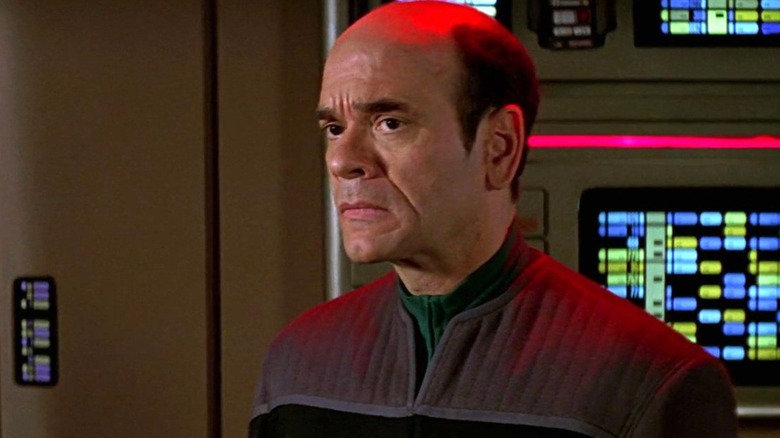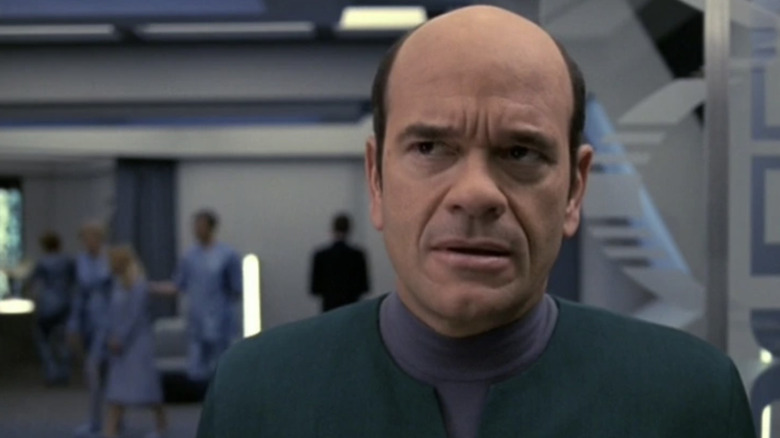The Clever Way Robert Picardo Earned His Star Trek: First Contact Role
"Star Trek: First Contact" arrived in theaters in 1996, while "Star Trek: Deep Space Nine" and "Star Trek: Voyager" were on television. So it's only appropriate that the movie included some cameos from those shows.
Worf (Michael Dorn), who had been introduced on "Star Trek: The Next Generation" and then joined "Deep Space Nine" in season 4, is introduced in "First Contact" commanding the Defiant, the ship from "DS9." Later, when the Borg invade the Enterprise, Dr. Beverly Crusher (Gates McFadden) uses an E.M.H. (Emergency Medical Hologram) to stall the invaders.
The E.M.H. is played by Robert Picardo, who also played the hologram on the ship in "Voyager." The idea is that these holographic assistants are standard for Starfleet ships. "Voyager" follows a ship that gets stranded halfway across the galaxy and loses several crewmembers, including the chief medical officer. Thus, the "Doctor" has to step up into that role, becoming a genuine member of the crew and a wholly-realized individual.
At the 2017 Toronto Comic-Con, Picardo revealed how he made this cameo happen. In "Star Trek: Generations," the Enterprise-D is destroyed, and "First Contact" debuts the new Enterprise-E. Picardo, who was having a meeting with "Star Trek" Producer Rick Berman, said the new Enterprise should have an E.M.H.
"Why does 'Voyager' have more advanced technology than your flagship?" Picardo recalled phrasing the question. When Berman asked why the E.M.H's on different ships would look identical, Picardo answered: "Why wouldn't they look alike? It's like a popular screensaver." Picardo continued to plant the seed for this idea among other important "Star Trek" writers/producers at the time, such as Ronald D. Moore and Brannon Braga.
According to Picardo, "First Contact" director Jonathan Frakes (who played Commander William T. Riker on "Next Generation") got the job due to his directing on "Projections," a well-received Doctor-centered "Voyager" episode. When Frakes called Picardo to thank him, Picardo mentioned the idea to Frakes, too. Someone recognized the good idea, and the rest is history.
The Doctor, or Star Trek's perfect Borg doorstop
You don't need the context of "Voyager" to understand the E.M.H. cameo in "First Contact." When Crusher brings the hologram online, he offers some brief exposition about his function and how it doesn't include creating diversions.
"I'm a doctor, not a doorstop," the hologram says, quoting Dr. "Bones" McCoy from the original "Star Trek." However, the hologram is an ideal diversion against the Borg, who work by assimilating organic beings into their cyborg hive mind. The E.M.H. has no physical matter to assimilate. The scene ends with a POV shot from a Borg drone staring down the E.M.H., who flatly offers the drone some skin cream for its robotic-implant-irritated flesh.
"Projections" also assisted this cameo in another way, because that episode revealed the E.M.H. program was designed by Starfleet's Dr. Lewis Zimmerman (Picardo), and that the Doctor was modeled on Zimmerman's own appearance. Of course, the program would have a standardized look and mannerisms. Zimmerman wasn't designing it for use on one ship, he was designing it for all of Starfleet.
This detail paid dividends for Picardo, because it scored him another guest appearance as Dr. Zimmerman in the episode "Doctor Bashir, I Presume?" on "Deep Space Nine." Zimmerman also later appeared in the "Voyager" episode, "Life Line," an episode carried by Picardo playing two parts.
The Doctor was easily one of, if not the most popular character on "Voyager," and a lot of that is due to Picardo's performance. It only made sense to put Picardo's Doctor in some extra spotlight — and to bring him back once more for the animated series, "Star Trek: Prodigy."

